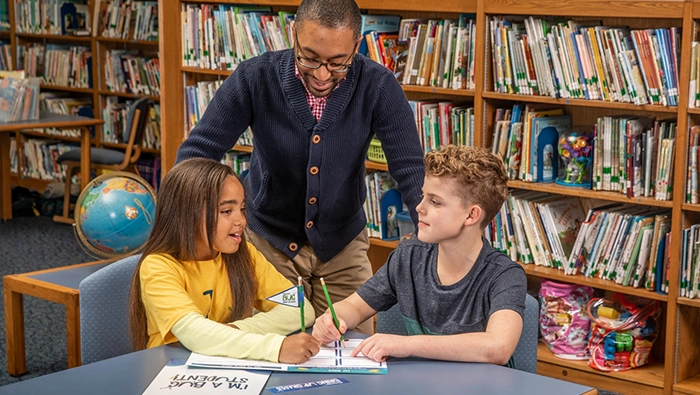The Kiwanis Children’s Fund honors 7 Key Club and CKI scholars in 2024.
By Erin Chandler
Out of over 500 applicants, the seven outstanding scholars who will receive this year’s Kiwanis Children’s Fund scholarships stand out as leaders and visionaries. Each recipient emphasizes that the values and skills they have learned in Key Club and Circle K International are the foundation for the difference they will make in the world — whether through science, medicine, politics and community organization, or education. The Children’s Fund is honored to help them continue their education in the upcoming academic year.

Samaira Lee
Linda Canaday Memorial Scholarship
Samaira Lee is a recent graduate of Fishers High School in Indiana, U.S., where she served one term as secretary-treasurer and two terms as president of her Key Club. She went on to serve as lieutenant governor for her Key Club division. Lee’s passion for service began when she was 7 years old, helping her parents serve meals to families of hospitalized children at the Ronald McDonald House. Last year, that passion came full circle when she organized pajama days at four local elementary schools to raise funds for Riley Children’s Hospital. That service helped show more kids how, in Lee’s words, “small acts of service make an impact in one’s community and incrementally create a better world.” In addition to Key Club, Lee was part of the 2024 Leadership Committee for the Leukemia and Lymphoma Society Student Visionaries of the Year, the student board for the Hamilton Southeastern Education Foundation, the Fishers High School National Honor Society, and the National French Honor Society. Next year, Lee will attend Northwestern University with a major in psychology and minors in economics and French. She plans to pursue a career in community leadership, with the goal of serving in state or national government.

Kyle Hanson
Kiwanis Children’s Fund Scholarship
Kyle Hanson is a recent graduate of Beaverton High School in Oregon, U.S., and the current president of Key Club International. He previously served Key Club as a district governor and club president. As governor of the Pacific Northwest District, Hanson developed a strategy for better engaging and supporting clubs in rural areas. The district subsequently grew by over 1,000 members, with record-breaking attendance at its convention. For the past two years, Hanson has worked at the Children’s Cancer Therapy Development Institute, contributing to research on the treatment of pediatric cancers. He has also served as student government president; co-president of the STEM education nonprofit Create Invent Aspire Science and of Club Hope, a student aid group focusing on homelessness; founder of his school’s chapter of the Oregon Math, Engineering, Science and Achievement program; project coordinator for the environmental activism club; and Beaverton-area dragon boat team captain. “By centering work around Key Club’s core values,” Hanson says, “I’ve built better relationships, got people more engaged and ultimately made a bigger impact.” Hanson will study economics and applied math at Harvard University. He hopes to pursue a career in biotechnology and run his own nonprofit.

Saumya Sikhwal
Kiwanis Children’s Fund Scholarship
Saumya Sikhwal recently graduated from South Warren High School in Bowling Green, Kentucky, U.S. She immigrated to the U.S. from India in 2020, and within a few months, while still adjusting to life in an American high school, she was elected lieutenant governor of her division in Key Club International. Sikhwal went on to receive the Robert F. Lucas Outstanding Lt. Governor Award and to further serve Key Club as secretary and governor of her district. She describes her decision to run for governor as the moment that changed her “from an indecisive person to a certain one, reticent to outgoing, a young leader who made mindful decisions.” Sikhwal is also a leader outside of Key Club, serving as a student council officer, National Beta Club social media chair, chess club president, taekwondo demonstration team lead and a national competitor in archery. As president of the youth advisory board for the tobacco prevention and cessation organization #iCANendthetrend, she has presented her advocacy at youth tobacco control conferences and in professional development series. Sikhwal plans to pursue a degree in biochemistry at the University of Louisville.

Sarah Khreizat
CKI Past Presidents Scholarship
Sarah Khreizat is a public health major at the University of Michigan – Ann Arbor. As club president, Khreizat took on the responsibility of rebuilding her club’s chapter of Circle K International following a sharp decline in engagement, successfully tripling the club’s membership and reactivating dormant community partnerships. In addition to CKI, she has been president of the Pay It Forward mentorship program and the Arabesque Dance Troupe. She has held leadership positions with the Hospital Elder Life Program at the University of Michigan Hospital, Arab American Health Initiative and Middle Eastern/North African Public Health. She has also served as an English tutor for Syrian refugees. Khreizat currently works as a research assistant in the Prevention Research and Health Equity Lab, where she studies factors associated with HIV in adolescents. She has presented her research at national conferences and in peer-reviewed journals. Khreizat says, “CKI taught me that even though a leader may face challenges along the way, there is always light at the end of the tunnel as long as we hold onto our values of passion for service and determination to make a positive change in our community.”

Matthew Yuro
John E. Mayfield CKI Scholarship
Already a recipient of a 2023 Kiwanis Children’s Fund Scholarship, Matthew Yuro is a special education, elementary education and history major at The College of New Jersey, U.S. He is the lieutenant governor of his Circle K International division, and he leads and serves on a number of CKI committees at the international, district and club levels. He is also a member of the Youth Homelessness Committee for the New Jersey District of Kiwanis International. In addition to his service with the Kiwanis family, Yuro is the president of the New Jersey Education Association Preservice and holds leadership positions with the National Education Association Aspiring Educators, Student New Jersey Education Association, Teachers of Young Children, multiple honor societies, history club and student government. He is also active as a peer mentor and is vice president of his college mentoring union. In his quest to become an educator, Yuro works as a substitute teacher at Mill Lake Elementary School and as a tutor for the Monroe Township School District and The College of New Jersey. “For me,” Yuro says, “Circle K International transcends being just a club; it is a community of like-minded individuals where I can be my best self.”

Jonathan Huang
Kiwanis Children’s Fund Scholarship
Originally from Houston, Texas, U.S., Jonathan Huang is a molecular and cellular biology major at Harvard University in Massachusetts, U.S. A former president of his high school’s Key Club, Huang founded the first virtual CKI club. With Huang as its president, the Circle K e-Club of the New England District has grown to include members from five universities and has the district’s highest fundraising total. Huang is also the chair of CKI’s Diversity, Equity and Inclusion Coalition. Outside of CKI, Huang is a peer advising fellow and holds leadership roles in the Harvard-Radcliffe Asian American Association, Harvard Undergraduate UNICEF, Harvard University Police Advisory Board and MakeHarvard, a competitive engineering organization. He works as an emergency medical technician for CrimsonEMS, an undergraduate research assistant in global health issues at MJ Lab and a Harvard admissions recruiter for first-generation students from low-income backgrounds. Huang says his experiences with CKI “serve as the backbone and foundation for everything I’ve been able to accomplish.” He plans to pursue a career as a physician.

Srishti Khadilkar
Kiwanis Children’s Fund Scholarship
Srishti Khadilkar of Oakville, Ontario, Canada, is studying physiology and interdisciplinary medical sciences at the University of Western Ontario. She is in her second term as governor for the Eastern Canada District of Circle K International, having previously served as chair of the Kiwanis Family Relations Committee. In the latter role, she helped plan events that enhanced the connections between CKI, Key Club and Kiwanis International. For Khadilkar, one of the most rewarding aspects of CKI leadership is that it has “strengthened [her] ability to empathize and communicate effectively, fostering a sense of community” between people of all ages and backgrounds. In addition to CKI, Khadilkar has been president of the Microbiology and Immunology Student Association and vice president of academics for Simply Scientific. She has also worked as a student volunteer at University Hospital. In her free time, she is a member of BRDRLESS Dance Studio. Khadilkar plans to take the values and interpersonal skills she has learned in CKI into her career as a dentist, providing affordable and convenient care to underserved communities.
Visit the Kiwanis Children’s Fund Scholarship Opportunities page for information about scholarships distributed by the Children’s Fund, including who to contact with questions and award notification dates.










